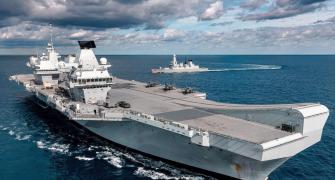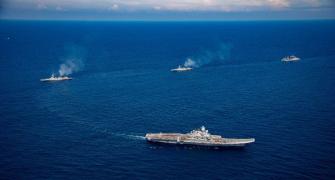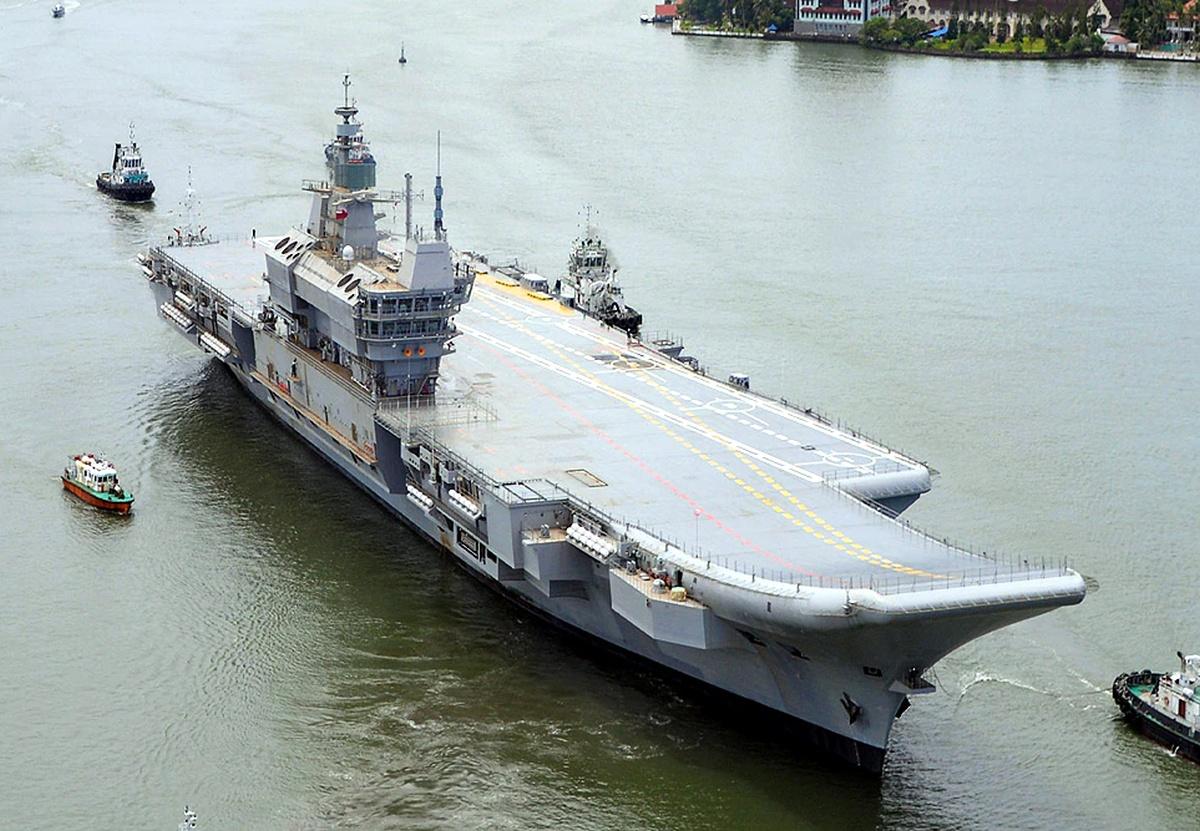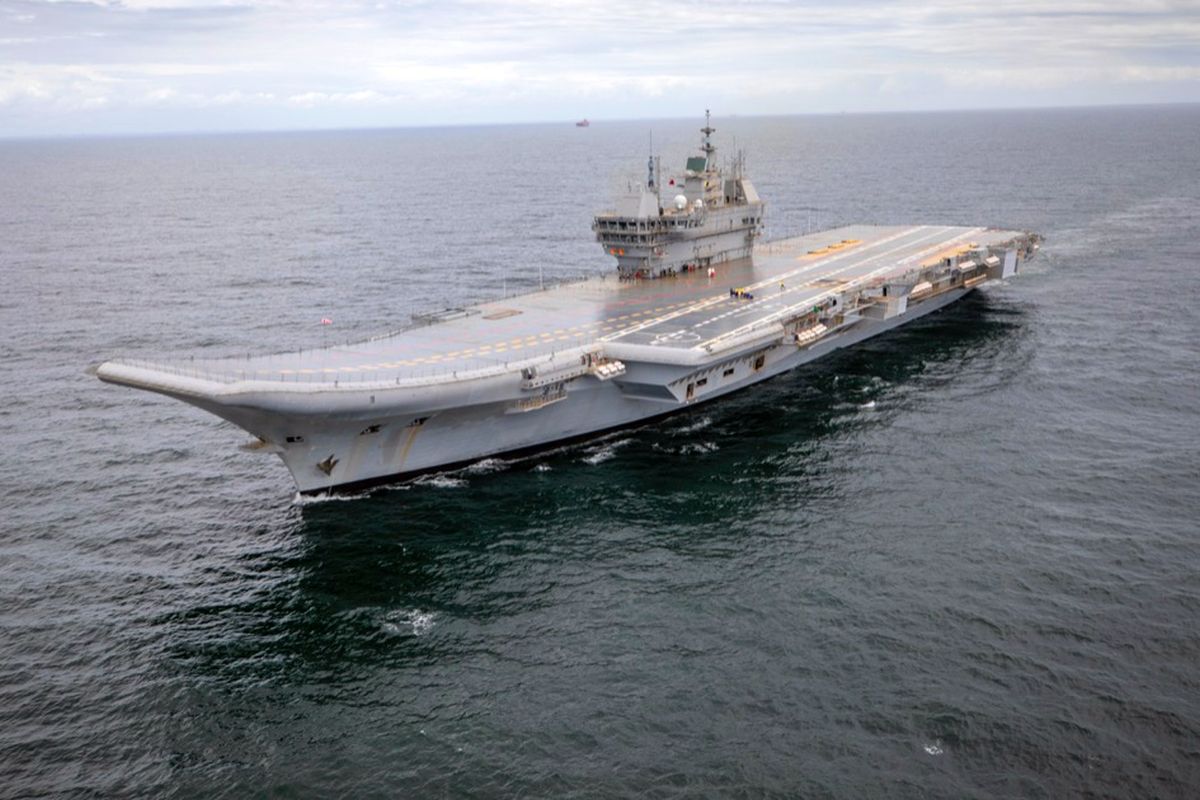In New Delhi's corridors of power, debate continues on whether the navy even needs a third aircraft carrier, reports Ajai Shukla.
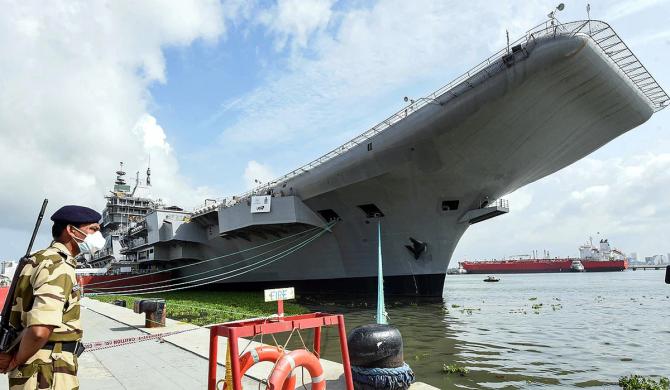
Aircraft carriers -- the name for warships that carry fixed wing fighter aircraft -- have been in the news recently.
In July, a flotilla of British warships, led by an aircraft carrier, the Royal Navy's flagship, Her Majesty's Ship Queen Elizabeth (HMS QE), transited through the Indian Ocean on her way to the South China Sea. This was the QE's first operational tour of those contested waters and was intended to demonstrate the 'Indo-Pacific tilt' in London's security policy.
In early October, the QE joined two American carriers -- United States Ship Ronald Reagan and USS Carl Vinson -- and a Japanese helicopter carrier, Japanese Ship Ise, to patrol the waters around Taiwan, where almost 100 Chinese military aircraft intruded into airspace that Taipei claims to control.
This was a show of military power and intent that aircraft carriers are well suited for. Former US secretary of state Henry Kissinger had famously remarked: 'An aircraft carrier is 100,000 tonnes of diplomacy.'
On its way back to the UK in October, the QE-led flotilla (called Carrier Strike Group 21) trained with the Indian Navy in the tri-service Exercise Konkan Shakti in the Arabian Sea. The navy did not field its lone aircraft carrier, Indian Naval Ship Vikramaditya, for the joint exercise.
On August 4, a landmark day for Indian shipbuilding, INS Vikrant, the country's first indigenous aircraft carrier (IAC-1), sailed out from Cochin Shipyard Ltd for her maiden sea trials. With her systems performing to expectation, the Vikrant is currently undergoing a second round of sea trials.
India's top government auditor discovered that the Vikrant is 12 years late in construction and will end up costing 13 times what was budgeted. Yet, it will remain a potent tool for coercion and signalling.
Then US president Theodore Roosevelt summed up his foreign policy as: 'Speak softly and carry a big stick; you will go far.' The US navy supercarrier named after him, USS Theodore Roosevelt, bears the nickname: The Big Stick.
In the second week of October, the four big Quadrilateral Group navies -- the Indian Navy, United States Navy, Japan Maritime Self Defence Force and the Royal Australian Navy -- trained together in Exercise Malabar 2021. Among the frontline ships that participated were the carriers, USS Carl Vinson and J S Kaga.
Earlier, on September 15, the US further reinforced the military architecture for confronting China, joining hands with the UK and Australia to create an 'enhanced trilateral security partnership' named AUKUS (Australia-UK-US).
While its first announcement was that the UK and US would provide Australia with the classified technology and wherewithal needed to build and operate up to eight nuclear-powered attack submarines, American aircraft carriers will form the spine of AUKUS.
In New Delhi's corridors of power, however, debate still continues on whether the navy even needs a third aircraft carrier.
Successive navy chiefs, including the current one, Admiral Karambir Singh, have publicly argued for having three carriers in service. This would allow two carrier battle groups (CBGs) -- each one with air, surface and sub-surface capabilities -- to project power in India's eastern and western seaboards simultaneously, with the third carrier in reserve or undergoing maintenance or repair.
An aircraft carrier, with integral air support from on-board combat aircraft, protects and gets protection from all components of the CBG -- multirole destroyers and frigates, anti-submarine corvettes, missile boats, logistics support vessels and submarines -- enabling the CBG to operate thousands of kilometres from land.
Opposition to a third carrier comes from the Indian Air Force, which claims it can provide air support to navy CBGs from shore-based airfields such as Car Nicobar and Thanjavur. It refers to the Andaman and Nicobar Islands as an 'unsinkable aircraft carrier'.&
This viewpoint is backed by the tri-service chief, General Bipin Rawat, who has publicly declared that an aircraft carrier costs too much, is overly vulnerable to enemy attack and that more submarines should be bought instead.
In fact, the further away from the coast the CBG operates, the less effective is shore-based air support, given the limited radius of action of fighter aircraft. And as a CBG sails further away, shore-based air support ceases to be effective at all.
For building a suitably powerful and capable IAC-2, India needs knowhow and skill from the US, French or British Navies, even after undergoing the experience of building INS Vikrant in CSL. That is because India has only operated small aircraft carriers of 44,000 tonnes or less.
Size matters in an aircraft carrier, since that determines how many aircraft it embarks. Roughly, a carrier can embark and operate one aircraft for every 1,000 tonnes it displaces.
The 44,000-tonne INS Vikramaditya embarks 36 aircraft -- 30 MiG-29K fighters and six Kamov helicopters. This air complement, however, is inadequate.
A carrier that is operating beyond the reach of shore-based air support requires 50-60 aircraft to protect the CBG, while also retaining offensive strike capability against enemy targets. That calls for at least a 65,000-tonne carrier, something that Indian shipyards have never built.
Not all the aircraft on board a carrier are fighters or combat helicopters. There are also airborne early warning aircraft -- radar-equipped, airborne command posts that control and direct carrier-deck fighters as threats develop.
The US navy uses the E-2D Hawkeye, a large, twin turbo-prop aircraft that needs a far longer deck for getting airborne than what is available in sub-45,000-tonne carriers like the Vikramaditya or Vikrant.
The US Navy found the solution in 100,000-tonne 'supercarriers' that launch aircraft with steam catapults -- a steam-driven piston that hooks on to the belly of an aircraft and accelerates it to take-off speed in just 2-3 seconds.
The newest American supercarriers of the USS Gerald R Ford class have replaced steam catapults with an 'electromagnetic aircraft launch system' (EMALS) that accelerates aircraft (including unmanned aircraft) precisely to take-off speed.
EMALS is smaller, lighter, quicker, and more powerful, and allows the take-off speed to be calibrated for different types of aircraft, reducing stress and wear on their airframes. It was earlier believed that EMALS requires so much power that a nuclear-propelled carrier would be essential.
With a nuclear propulsion solution nowhere in sight, the Indian Navy is veering round to the belief that the answer could lie in the QE's 'integrated all-electric propulsion system',
That is based on two Rolls-Royce MT30 gas turbine alternators (36 megawatts each) and four Finnish Wartsila diesel generators that each provide 10 MW. These generators drive electric motors provided by US firm GE Power Conversion, propelling the 65,000 tonne carrier at 32 knots (60 km per hour) and also power the EMALS.
Ultimately, an aircraft carrier's combat power depends upon the robustness and combat power of the aircraft that it operates and what sortie rates it can generate.
The Russian MiG-29K/KUB, which was specially developed to operate off IAC-1, has emerged as a major disappointment. Since it arrived, it has been riddled with problems relating to its airframe, RD MK-33 engine and fly-by-wire system.
The serviceability of the MiG-29K ranged from a disgraceful 15.93 per cent to 37.63 per cent; and that of MiG-29KUB from 21.30 per cent to 47.14 per cent.
Numerous defects relating to failure of airframe parts had occurred during deck operations, most of them caused by the high impact of the MiG-29K/KUB fighters during touch down.
While MiG has made some improvements, the navy will have to expedite the ongoing procurement of 57 'carrier based multi-role fighters' from the global market, or the 'twin-engine deck-based fighter' that the Defence Research and Development Organisation is developing indigenously.
Only then would IAC-2 be a carrier that can confront the Chinese navy on equal terms.


